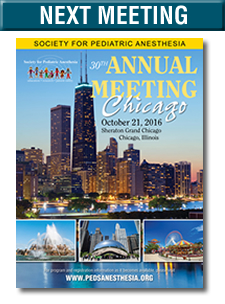other meeting reviews
2016 SPPM Annual Meeting Session 3:
Clonidine - PRO/CON
Reviewed by Connie Monitto, MD, FAAP
Johns Hopkins University School of Medicine
Benjamin Lee, MD, MPH (Charlotte Bloomberg Children’s Center at Johns Hopkins Hospital, Baltimore) moderated a lively PRO/CON debate on clonidine. The objectives of the debate included a review the roles, efficacy and limitations of systemic clonidine in pediatric pain management, a discussion of the use of clonidine in interventional pediatric pain management techniques, and an assessment of the risks and benefits of clonidine administration in pediatric patients.
Dr. Stephen Hays (Monroe Carrell Jr. Children’s Hospital at Vanderbilt, Nashville) opened the debate by presenting the PRO argument. He first reviewed a little history about clonidine. Specifically, clonidine is an imidazole alpha-2 adrenergic agonist that was first synthesized in 1962. It was approved for use by the FDA in 1974 for the treatment of hypertension and in 2010 as an adjunct in the management of Attention Deficit Hyperactivity Disorder. In addition, it has long been known to decrease anesthetic requirements. However, as he reminded the audience, most prescribing of clonidine in pediatric anesthesia and pain medicine practice involves off-label use of the drug.
Dr. Hays then proceeded to both entertain and educate the audience by describing his “Top 10 Reasons” to include clonidine in our practice. His first reason (Reason # 10) was that clonidine is inexpensive. This is especially relevant when comparing it to its more receptor-specific cousin,dexmedetomidine. Dexmedetomidine costs 70 times more than clonidine, and, as a result, when converting from a dexmedetomidine sedative infusion to enteral clonidine in adults, clonidine was shown to be 100-fold cheaper (Gagnon 2015).
He proceeded to remind us that clonidine is anti-nociceptive. Clinically, when added to intrathecal morphine it has helped overcome the problem of tolerance in cancer pain (van Essen 1988), and it has also been used successfully as an adjunct in single shot caudals where it prolongs analgesia. Clonidine is anti-neuropathic, potentiating the neuropathic pain-relieving actions of NMDA antagonists in animal studies (Jevtovic-Todorovic 1998). Studies have also shown that clonidine is renal-protective. It decreases the nephropathy seen with radiocontrast (Billings et al 2008), and was previously shown to help prevent deterioration of renal function after cardiac surgery, though this potential benefit was not supported by the more recent POISE study.
Another attribute from a pain management perspective is that clonidine is opioid sparing. It can decrease the need for fentanyl and midazolam infusions in ventilated neonates when co-administered by infusion (Hunseler 2014), as well as decreasing the need for supplemental analgesia with tramadol when administered epidurally (Klamt 2003).
When used as a sedative, it is generally not a respiratory depressant, and when used as a premedication it has been shown to be a good alternative to midazolam (Almenrader 2008, Bergendahl 2006). An additional benefit is its ease of administration. It can be given via the intranasal, oral, intravenous, epidural, or transdermal route, making it particularly useful. From an anesthetic perspective, clonidine has been shown to be a useful regional anesthesia adjuvant, prolonging peripheral nerve block duration (Cucchiaro 2007), in addition to its effect on neuraxial blockade. It also decreases the risk of emergence agitation after sevoflurane anesthesia (Costi 2014, Bock 2002).
Dr. Hays closed by presenting data demonstrating that clonidine is not neurotoxic, and has, in fact been neuroprotective for ketamine effects in animal models (Ponten 2012). As such it may fall into the category of medications that do not interfere with the properties of anesthetic drugs but can help inactivate intracellular signals that trigger neuroapoptosis (Olney 2007), making it a particularly desirable medication in our pediatric pain management armamentarium.
Dr. Karen Boretsky, (Boston Children’s Hospital) a self-proclaimed “Regional Anesthesia Enthusiast,” was less enthusiastic about our use of clonidine as she presented her CON argument, in which she described “The Good, the Bad (So-So) and the Ugly” of clonidine. Under the category of good, she too endorsed clonidine’s effectiveness as a preoperative anxiolytic with the ability to decrease postoperative opioid consumption (Lambert 2014). However, she was less supportive of the role of clonidine in caudal anesthesia. While a published meta-analysis does report a prolongation of block by two to four hours, she observed that the studies included were highly variable, so much so that a funnel plot analysis indicated potential publication bias. In addition, in many of these studies block duration was measured by the surrogate time to request of first analgesic, but a delay in analgesic need could have also resulted from clonidine-related sedation.
On the “bad” side, clonidine administration can result in bradycardia, sedation, and hypotension (the original indication for using the drug), raising the question of whether the benefit of additional block time is worth these potential side effects. Considering peripheral nerve blocks, she reported that two randomized controlled trials showed no improvement in blocks, while the 2007 study by Cucchiaro and Ganesh that Dr. Hays had quoted did show a trend to prolonged sensory blockade but this came at the price of a prolongation of the motor block as well, which may not be desirable. She also reminded the audience that peripheral nerve blocks can be prolonged with other medications as well -- for example administration of intravenous dexamethasone (Rahangdale 2014, Abdullah 2015), and she suggested that this might be a better alternative for the audience to consider.
Addressing the “ugly” side of clonidine, she described a number of case studies as well as a PRAN report from her own institution in which children who had received clonidine had developed transient but persistent paresthesia. Finally, she reminded the audience that while we generally consider clonidine as not having respiratory depressant properties, there is a potential for apnea in neonates who receive caudal clonidine, as well as in rare instances the potential for accidental medication overdoses resulting in clonidine poisoning.
For further reviews of the SPPM meeting, please read the most recent SPPM newsletter.





